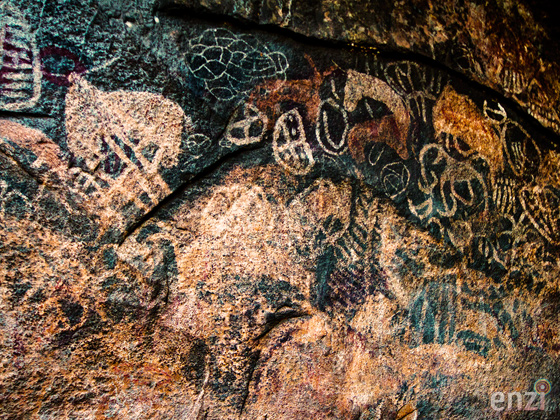- Home
- The Universe
- Human Origins
- The first ape men
- Proconsul
- Nakalipithecus
- Chororapithecus
- Sahelanthropus
- Orrorin Tugenensis
- Ardipithecus Kadabba
- Paranthropus aethiopicus
- Australopithecus Anamensis
- Ardipithecus Ramidus
- Australopithecus Afarensis
- Australopithecus Africanus
- Australopithecus sediba
- Paranthropus boisei
- Paranthropus robustus
- Kenyanthropus platyops
- Australopithecus garhi
- Stone age cultures & technologies
- Stone Age ancestors
- Out of Africa Migration
- The first ape men
- Civilisation
- Peoples & Cultures
- Interactive Exhibitions
- Museums of Kenya
Hunters & Gatherers
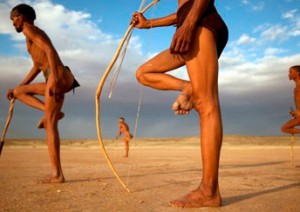
San men.
Origins: Until about 5,000 years ago, all of the East Africa territory was peopled by hunter-gatherers.
Main economic activity: Hunting and gathering. They knew the behaviour and habitats of animals that provided meat, skins and horns which they used for their daily lives. They also knew where and when to find the plants that supplied them with grains, tubers, nuts and berries for food and bark cloth, dyes, cosmetics, incense and medicines.
These bands of people moved around the land with the sophisticated knowledge of where to find the stones for tools and whatever else was needed.
Other names referring to now extinct hunter gatherer communities in different geographic locales are Lowland Nyika, Ngiwakinyang Ik, Gumba, Sandawe and Ngibotok.
Another group generally described as the Twa are hunting peoples who are said to be the aboriginal inhabitants of the forest before the advent of agriculture. In the Western Kenya region of Amagoro, near the Uganda border, there are rock paintings at Kakapel village attributed to the Twa peoples dated up to 4,000 years ago. Today the Twa people are found in Congo, Angola, Namibia, Zambia and Botswana. In South Africa, the term Twa is applied to the San, the former hunter gatherers of the region.
The following table contains descriptions of hunter gatherer communities that are still represented in Kenya. Some are on the verge of extinction.
Language: Yaaku.
Alternate names: Mugogodo, Mukogodo, Mukoquodo, “Ndorobo”, “Ntorobo”, Siegu, Yaakua, Yiaku.
Language family: Afro-Asiatic, Cushitic, East, Yaaku.
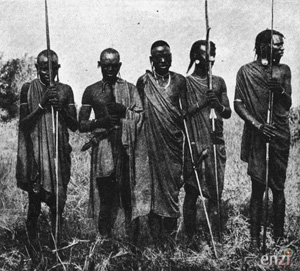
Mukogodo hunters.
Origins of the community: The Mukogodo represent a second wave of Cushite immigration into the Rift Valley area of East Africa. The earlier Southern Cushites were the first settlers we know of following the indigenous San (Bushmen). According to the oral tradition of both the Yaaku and their neighbours, the Yaaku were the first inhabitants of the Mukogodo forests and people still remember that they lived in the caves and made a living from hunting, gathering and bee-keeping and wild honey collection. After the intrusion by the Maasai, Maasai became the dominant language of the area. A change in economy towards cattle keeping was accompanied by a shift in language towards Maasai.
Population: According to an article titled “Only Seven can Speak Dying Language” on the Daily Nation on March 5, 2010 by Samwel Kumba and Mwangi Ndirangu, the total population of the Yaaku stands at 6,000. The story came following the death of one of the remaining eight people who could speak pure Yaaku language -Yakunte- fluently without using words borrowed from the Maasai community, which is the dominant language in their region. The remaining seven people who speak the language are aged over 70.
Geographical location of the community: After their last migration, the Yaaku settled in Laikipia District, Mukogodo Division, Mukogodo Forest west of Doldol, and the foothills north of Mount Kenya. The Yaaku live in the Mukogodo forest west of Mount Kenya, near Dol Dol, a division of the Laikipia District of Rift Valley Province, Kenya. The Mukogodo forest spans an area of 30,000 hectares of rugged hillside terrain in north-east of Laikipia.
Housing: Until the mid 1920’s the Mukogodo were hunter-gatherers, and lived a semi-nomadic existence making homes in caves and rock shelters. They kept bees and their diet was one of honey and meat. Since being assimilated into the Maasai culture, they live in manyattas.
Economic activities: The Yaaku were formerly hunter-gatherers and bee-keepers, but have partly assimilated to the pastoralist culture of the Maasai in the first half of the 20th century, although some still keep bees.
The Mukogodo obtained stock by marrying their daughters to Maasai herders in exchange for animals, by trading forest products and later, by earning cash from European-owned ranches and doing other work. By the 1940s or so, the Mukogodo had almost entirely changed from the old subsistence practices, save bee keeping.
Until the mid 1920s the Mukogodo were hunter-gatherers, living a semi nomadic existence. For subsistence they gathered wild foods, hunted hyrax, buffalo, giraffe, elephant, rhino and other game, and kept bees. They described their diet as one of ‘honey and meat’. Beehives are about a metre long made of a hollow log with lids at each end and small openings. They also harvested honey from natural hives in hollow trees and rocks. In the early days the honey was carried in buckets carved from wood (called Chang’orr) and fitted with leather caps.
Sometimes trapping as a hunting tactic resulted in more food than a group could consume, and the Mukogodo preserved the meat by cooking it until it was dry, mixing it with fat, and then storing it in a container in a rock shelter.
Marriage: In the 20th century, when Yaaku women began marrying neighbouring Maasai pastoralists, their parents received livestock as bride wealth, not only beehives, as was the Yaaku custom. According to Cronk (1989) this was ultimately the main cause for abandoning the hunter-gatherer way of live, as Yaaku parents now demanded cattle as bride wealth, also from young Yaaku grooms.
Before the 1920s or so when a Mukogodo man married a Mukogodo girl, he paid a few beehives as bride price. From the 1920s or so however, the Mukogodo began to marry their daughters off at a more considerable bride price to neighbouring pastoralists, who gave livestock, rather than beehives. Few fathers were willing to settle for beehives when they could obtain livestock and this encouraged Mukogodo to obtain and keep livestock in order to ensure that they and their sons would be able to acquire and keep wives.
Language: Dahalo.
Alternate names: Guo Garimani, or Sanye. Language family: Afro-Asiatic, Cushitic, South.
Origins of the community: The original homeland of the Southern Cushitic language family lies in south-west Ethiopia. Population According to the 2009 Kenya population and households census results the Dahalo number 2,398. The Dahalo language is an endangered language spoken by at most 400 people on the Kenyan coast near the mouth of the Tana River.
Geographical location of the community: After their last migration, the Dahalo settled in Coast Province’s Lamu and Tana River districts, and near Tana River mouth.
Economic activities: They were hunter/gatherers, with traditionally about 80% of their diet consisting of plant food, including berries, nuts, roots and melons gathered primarily by women. The other 20%of their diet composed of meat from wild animals. The Dahalo supplement their subsistence through hunting and gathering. The Dahalo formerly hunted elephants, likely selling their tusks to Arab traders who adored them for their ivory.
The name El Molo came from a Maasai phrase meaning “those who make a living from other sources other than cattle”. The Samburu name for El Molo is “loo molo onsikirri” which means “the people who eat fish”.
Language: El Molo. Alternate names: Dehes, Elmolo, Fura-Pawa, Ldes, “Ndorobo”.
Language family: Afro-Asiatic, Cushitic, East, Western Omo-Tana.
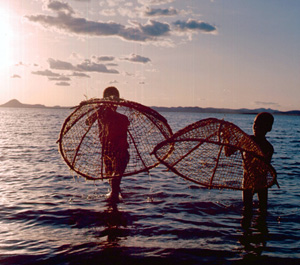
El Molo boys fishing in Lake Turkana.
Origins of the community: The origin of the El Molo is up to question: some say Ethiopia, others say Somalia. They originally settled on the northern shores of Lake Turkana, but other tribes forced them to move south to the small islands. They were further pressured by the tribes inhabiting that area, they moved further south to the south-eastern shores where they live today.
Population: According to the 2009 Kenya population and households census results the El Molo number 2,844. In 1994 the El Molo language speakers numbered 50. El Molo language was thought to be extinct in the middle part of the 20th century, but a few speakers were found in the latter half of that century. The El Molo tribe is the smallest ethnic group in Kenya, numbering about 300 people. According to a number of historians, the ‘pure’ El Molo may number only forty. The rest being of combined Samburu and Turkana bloodlines. Most of the ethnic group now speak Samburu or Turkana.
The community has been for the most part socially cut off from their neighbours. By 1958, the only newcomers to the El Molo in living memory had been three Turkana men. No women had been married off to other groups. Altogether, there were 143 persons living in two villages 3 miles apart on the south-eastern shore of the Lake. They comprised 36 adult males, 40 adult females, 37 unmarried boys, and 30 unmarried girls.
Geographical location of the community: After their last migration, the El Molo settled in Eastern Province’s Marsabit District, Lake Turkana south-east shore, and Elmolo Bay. The El Molo live on the south-eastern shores of Lake Turkana. They are gathered into two villages, one called Anderi consisting of about 150 individuals and the other, Illah of about 70 inhabitants. Temperatures reach 120F (49°C), average rainfall in the area is 50-60mm, and the land is constantly buffeted by hot desert winds.
Housing: The El Molo live in round huts, which they make from doum palm (an Egyptian palm tree, with a divided trunk and edible apple-sized fruits) fronds and are supported using wood from the acacia tree. Their dwellings resemble igloos, built from what little scrub vegetation there is to be found amongst the volcanic wasteland surrounding the alkaline waters of Lake Turkana.
Economic activities: Their main diet is fish from Lake Turkana. They mainly fish for the giant Nile perch and occasionally hunt crocodiles and hippos. They fish using hand made harpoons from acacia roots and fishing nets made from doum palm (an Egyptian palm tree, with a divided trunk and edible apple-sized fruits) logs. The life of the El Molo is generally based on fishing, using spears or harpoons, fishing rods (made from the roots of an acacia with doum palm fibre and a forged iron point or hook) and nets (made from doum palm fibre). They use traditional rafts made of doum palm logs and tied with a rope. Unlike the Samburu and Turkana, the El Molo are not pastoralists – they do not keep cattle. Apart from fish, they also eat ‘loka’, the nut or date of the doum palm-eaten mostly by children.
Language: Waata. Alternate names: Ariangulu, Langulo, Sanya, Sanye, Waat, Wasanye. The Waata historically interacted with different groups who had different names to refer to the Waata: the Kamba and Mijikenda groups call them Waliangulu (‘eaters of meat’), the Swahili refer to them as Wasanye (foragers), and the Amhara of Ethiopia know them as Weyto.
Language family: Afro-Asiatic, Cushitic, East, Oromo.
Origins of the community: The origins of the Waata are not clearly known, but their ancestors are probably made up of a root group of southern Cushitic-speaking hunter-gatherers, referred to in oral traditions as Laa near the coast and Asi or Degere in the interior up to the Taita Hills, with additions from Waata who followed the Orma on their migrations south from the Tana. The Laa/Asi made a language shift to Oromo as they established trade and cultural relations with the more powerful pastoralists, and mixed with or became absorbed by the immigrant Waata between 17th and late 19th centuries. They also took in various Orma and Bantu people who were destitute, outcasts or runaway slaves.
According to the legend of the Waata, their ancestors were Boran who became hunters when their cattle turned into wild animals. It is known that passage from pastoralism to hunting is a common process and that ivory trade flourished in the Tana region and was largely under the Oromo control from at least the 17th century. The ancestors of the Waata might have followed the Oromo traders as clients towards the coast or possibly could have been sold as slaves to Arab traders for use as elephant hunters before eventually being emancipated. As Giriama farming expanded, Waata were progressively pushed from the coastal fringe and followed the vanishing elephant herds into the Tsavo-Galana area.
There are two groups of Waata hunter-gatherer communities, with one living in symbiosis with the Oromo-speaking (Boran) pastoralists in northern Kenya while another Waata group is found scattered in the coastal hinterland and is usually known as Waliangulo. The Waata living with the Boran are a case of complete acculturation, although acculturation does not necessarily amount to assimilation.
There are several Oromo-speaking (Eastern Cushitic) subgroups of Waata living along the western side of the Tana River and on the coastal hinterland down to northern Tanzania. They are called Ariangulo by the Giriama and Langulo by the Duruma and Digo, Waata by the Orma and themselves, Juan by the Aweer, and Oriothotanyi by the Dahalo.
Population: According to the 2009 Kenya population and households census results the Waata number 12,582. According to SIL Ethnologue the population count for the Waata stood at 17,400 in2006 and showed an increasing trend.
Geographical location of the community: After their last migration, the Waata settled in Coast Province’s Lamu District; and Tana River lower parts.
The Waata are not a homogeneous community. They live in scattered territorial groups along the Tana and Galana Rivers and in the Taru Desert in eastern Kenya, on the Kenyan coast, in Marsabit District in northern Kenya, and in parts of southern, central and western Ethiopia
Economic activities: Traditionally, the Waata were a community of hunter-gatherers. They, together with the Orma and Maasai pastoralists remained in their homeland in Tsavo until 1948, when it was gazetted as a national park. The indigenous populations were relocated to Voi and Mtito Andei as well as other locations within the nearby Taita Hills.
The Waata are known as Worra Guubbe (people of the bow), in distinction to Worra Dase (people of mats) and Worra Buyoo (people of grass). However, the restriction on hunting in colonial days and now its total ban, combined with drastic decrease in the number of animals, means that the Waata no longer hunt for a living, though they may do a little surreptitiously (secretly). The animals they hunted include: elephant, giraffe, kudu, oryx, ostrich, anteaters and porcupines.
The Waata together with the Aweer were the main suppliers of ivory to the coast for export. The hunting (poaching) bands of the Taru-Tsavo area were broken up in the 1950s-1960s by the colonial government and today work on farms. They are being assimilated by the Bantu Mijikenda (Nine tribes) through intermarriage, and have lost much of their interdependence with the Orma.
Language: Aweer. Alternate names: Aweera, “Boni”, Waata, Wata, Sanye, Wasanye, Waboni, Bon, Ogoda, Wata-Bala.
According to the Aweer, the word ‘Aweer’ means lower caste or the unlucky.
Language family: Afro-Asiatic, Cushitic, East, Rendille-Boni.
Origins of the community: The Aweer are believed to be descendants of the Boni, a community estimated to be fewer than 50,000 people living in Lamu District. They refer to their settlement as Junction Aweer. It his home to 327 persons in 50 families. Their history dates back to the lucrative slave trade along the coast of East Africa. To avoid being captured, brutalised and sold into slavery, the Aweer fled inland and settled in Boni forest that stretches from Lamu to the southern part of Ijara district.
Until the 1980s the families in Aweer community carried on with their traditional way of life – hunting and gathering. However, the banditry that has ravaged North Eastern Province forced them out of their forest homes. They live in forest groves and usually light bonfires to ward off wild animals that roam the forests.
Population: According to the 2009 Kenya population and households census results the Boni number 7,602. According to the 1999 population census, there were around 2000 Aweer living in Kenya. However, the tribe and their language are had not been officially registered.
Geographical location of the community: After their last migration the Aweer settled in Lamu and Ijara districts of north-eastern Kenya and extends to Somalia.
The Aweer/Boni inhabit the area near the Dahalo in the forest hinterland between Lamu and the Somali border.
Economic activity: They are known for their innovative practice of using semi-domesticated birds to find honey, with whistling signals. Their remote territory is heavily wooded and the tribe is traditionally hunter-gatherers.
Trade: At the opening of the last century, the Aweer were exchanging ivory for manufactured goods, iron, tobacco and flour and for goats and cattle which they slaughtered for food other than keeping as wealth.
Language: Daasanach. Alternate names: Daasanech, Dama, Dasenech, Dathanaik, Geleb, Geleba, Gheleba, Marille, Reshiat, “Shangilla”. Spoken by the Daasanach in Ethiopia and Kenya. Their homeland is along the Lower Omo River and on the shores of Lake Turkana.
The Daasanach are sometimes called Merille.
Language family: Afro-Asiatic, Cushitic, East, Western Omo-Tana.
Origins of the community: The Daasanach are an ethnic group of Ethiopia, Kenya and Sudan. Their main homeland is in the Zebub Omo Zone of the Southern Nations, Nationalities and People’s Region of Ethiopia, around the North end of Lake Turkana.
Until the turn of the 19th century, little was known of the Daasanach. When formal borders were created for many African countries, the Daasanach found their traditional lands divided between Sudan, Ethiopia and Kenya.
The Daasanach are an off-shoot from Ethiopia at the Turkana border. Daasanach ancestors called ‘Baz’ are thought to have been around Lake Turkana as early as 2,500 years ago. They lived along the north eastern shores of Lake Turkana.
Population: According to the 2009 Kenya population and households census results the Daasanach numbered 12,530. 10% of the Daasanach population live in Kenya. According to the 2007 national census, they number 48,067 people (or 0.07% of the total population of Ethiopia).
Geographical location of the community: After their last migration, the Daasanach settled in Eastern Province’s Marsabit district, Lake Turkana north-east shore, and Illeret area.
Housing: The Daasanach who herd cattle live in dome-shaped houses made from a frame of branches, covered with hides and woven boxes (which are used to carry possessions on donkeys during migration). The huts have a hearth, with mats covering the floor used for sleeping.
Economic activities: The Daasanach are a primarily agropastoral people; they grow sorghum, maize, pumpkins and beans when the Omo river and its delta floods. For the most part they rely on their goats and cattle for milk, and are slaughtered in the dry season for meat and hides. Sorghum is cooked with water into a porridge eaten with a stew. Corn is usually roasted and sorghum is fermented into beer.
People who have lost their cattle and way of living are known as the Dies or lower class. They live on the shores of Lake Turkana hunting crocodiles and fishing.
Their staple diet consists of milk, sorghum, meat and fish. During the dry season, food is often scarce. At these time some food gathering occurs.
Trade: The Dies (lower class) living on the shores of Lake Turkana trade crocodile meat and fish for meat from the herders.
Initiation: Women are circumcised by removing the clitoris. Women who are not circumcised are called animals or boys and cannot get married or wear clothes. Boys are also circumcised. The oldest daughter is initiated into adulthood at the age of 7-9 years during the Dimi celebration -whose feasts and rituals last up to 6 weeks. The father of the girl emerges as an elder in his clan.
Marriage: Women wear a pleated cowskin skirt and necklaces and bracelets, are usually married off at 17. Men wear only a checkered cloth around their waist. They get married at 20.
Language: Okiek. Alternate names: Akie, Akiek, Kinare, “Ndorobo”, Ogiek. Okiek is a member of the macro-language Kalenjin. The Okiek, sometimes called the Ogiek or Akiek (although the term Akiek sometimes refers to a distinct subgroup), are an ethnic and linguistic group based in north-western Tanzania, Southern Kenya (in the Mau Forest), and Western Kenya (in the Mount Elgon Forest).
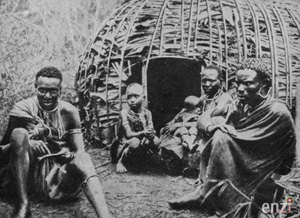
Ogiek family.
Some “Ndorobo” languages have few remaining speakers. The Akiek of northern Tanzania now speak Maasai. The Akiek of Kinare in Kenya now speak Gikuyu. “Ndorobo” is a derogatory term for several hunter or forest groups, not linguistically related (El Molo, Yaaku, Okiek, Omotik, Aasáx).
The name Dorobo is derived from a Maasai name il torobo which means a “poor person who has no cattle and has to live on hunting and gathering”.
The majority of the Ogiek speak a Kalenjin-related dialect as their domestic language. Most local groups also live near one of the Kalenjin tribes such as the Kipsigis, the Nandi, the Tugen and the Marakwet, and their Kalenjin dialect will tend to be more similar to that of the neighbouring tribe. Those who live in close proximity to the Maasai in Mukogodo and Narok speak Maasai dialects and not Kalenjin languages but they claim to be of the same historic origins as the Kalenjin-speaking Ogiek.
Language family: Nilo-Saharan, Eastern Sudanic, Nilotic, Southern, Kalenjin, Okiek.
Origins of the community: The Ogiek are believed to be the first people to settle in Eastern Africa and were found inhabiting all Kenyan forest before 1800AD. Due to domination and assimilation, the community is slowly becoming extinct with the 1989 figures showing about 20,000 countrywide. The Ogiek are the last remaining forest dwellers and the most marginalised of all indigenous peoples and minorities in Kenya.
The Ogiek community is believed to have occupied the coastal regions of East Africa as early as 1000 AD. They moved from these areas following attacks by slave traders and other migrating communities. This was the Ogiek’s first dispersal. It saw one group moving into Tanzania where they settled among the Hadzabe and Maasai tribes. This group has been assimilated by the Maasai and now speaks a dialect that is very close to Maasai. A second group moved to the plains of Laikipia bordering Mount Kenya Forest from where they dispersed to various locations in northern, central and western Kenya.
By the turn of the century, the Ogiek were to be found in Mount Elgon, Cherangany, Koibatek and Nandi, as well as the Mau Forest region, which straddles Nakuru, Narok, Kericho and Bomet districts in the Rift Valley Province of Kenya. One group moved from Laikipia and settled in Samburu, Northern Kenya.
Population: According to the 2009 Kenya population and households census results the Ogiek number 78,691.
Geographical location of the community: After their last migration, the Ogiek settled in Rift Valley Province’s Nakuru district, East Mau Escarpment; Sogoo in Mau Forest south between Amala and Ewas Ng’iro rivers near Nosogami stream. Also in Tanzania.
The western Mau Escarpment where Kaplelach, Kipchornwonek, and several other Okiek groups live is a forested slope, roughly 66km long, rising in altitude from 1800 to 2800m. Okiek recognise five altitudinally related ecological zones, ranging from open bush forest below 2100m (soyua) to high, dense bamboo forest between 2400 and 2600m (sisiyuet), each zone is distinguished by its most common plant and animal species. Zones have different honey-producing species and honey seasons which have determined Okiek patterns of mobility.
Economic activities: The Ogiek are a hunter-gatherer community of forest dwellers who depended on Mau Forest for subsistence and shelter in the early part of the 20th century. The community divided the forest among their clans using natural features like valleys, rivers and hills as boundaries. The Ogiek depended on the forest for their livelihood. Collection of wild fruits, hunting, honey harvesting were a daily routine.
While meat for the Mau Okiek comprises 75% of their diet, honey (comprising but 15%) is the primary motivation for forest exploitation. There is a striking lack of wild vegetables in the Okiek diet, and it is only children who eat significant amounts of berries and roots.
The animals hunted once included bushbuck, buffalo, elephant, duiker, hyrax, bongo, and giant forest hog. They hunted with dogs, bows and arrows, spears, and clubs, using poison for buffalo and elephant. Men also set traps. Unlike many other hunter-gatherers, Okiek gathered little plant food; they relied on a diet of meat and honey, supplemented by traded grains. In the late 1930s and 1940s Kipchornwonek clan planted small millet gardens; and later the Kaplelach planted maize. Over the next twenty years, however, agriculture became more important. Okiek began to settle more permanently in mid-altitude forest and keep their few domestic animals at home.
The Ogiek are self-sufficient in forest products (wild fruits and roots, game hunting, honey) except for small amounts of iron for making into arrowheads, spears and knives.
Initiation: Initiation was performed around age fifteen, separately for boys and girls.
The Ogiek have age-set systems similar to those of the Maasai or the Kalenjin Ipinda. Their initiation ceremonies show superficial resemblance to both Kalenjin and Maasai initiation ceremonies and their initiated young men (muranik) act as the community police against feuding between lineages, and first line defence against attacks and raids by other local groups or tribes. The age-set system also acts as the basis for peer group relations among the men who grow up together as friends, sharing activities in hunting, honey collecting, raiding, dancing and socialising. Major Okiek ceremonies celebrate stages of social maturation: a head-shaving ceremony where a child receives a new name; an ear-piercing ceremony at age twelve to fourteen (now rarely practised); and initiation into adulthood.
Ndorobo is a term considered derogatory, occasionally used to refer to various groups of Nilotic and Cushitic hunter-gatherers.
In the past 150 years, many of these peoples have assimilated to the pastoralist economy of neighbouring peoples (mostly Maasai and Samburu), and have, in the process, abandoned their own languages.
The term ‘Dorobo’ derives from the Maa expression il-tóróbò (singular ol-torróbònì) meaning ‘hunters; the ones without cattle’. Living from hunting wild animals implies being primitive, and being without cattle implies being very poor in the pastoralist Maa culture.
Groups that have been referred to as Dorobo include:
- Kaplelach Okiek and Kipchornwonek Okiek (Nilotic; Rift Valley Province, Kenya)
- Sengwer
- Mukogodo-Maasai (the former Yaaku, sometimes Aramanik) (East Cushitic; Laikipia District, Rift Valley Province, Kenya)
- Aasax (South Cushitic; northern Tanzania)
- Akie (sometimes Mosíro, which is an Akie clan name) (Nilotic, northern Tanzania)
- Mediak (Kalenjin, northern Tanzania)
- Kisankasa (Kalenjin, northern Tanzania)
- Aramanik (Kalenjin, Tanzania)
- Mosiro (Kalenjin, Tanzania)
- Omotik
Language: Omotik. Alternate names: Laamoot, “Ndorobo”, Omotic, spoken by the Omotik.
The Omotik are one of the groups commonly called Dorobo. “Ndorobo” is a derogatory cover term for several small hunter or forest groups, not linguistically related (El Molo, Yaaku, Okiek). The term Dorobo is the Swahili-derivative of the Maasai term ‘Torobo’ meaning a poor person, a person without cattle.
Language family: Nilo-Saharan, Eastern Sudanic, Nilotic, Southern, Tatoga.
Population: In 1980 the number of Omotik language speakers stood at fewer than 50 speakers, all above the age of forty years and most of them were women.
Geographical location of the community: After the last migration, the Omotik settled in Rift Valley Province’s Narok district around Lolgorien, Entasekera, and the Lemek area.
Economic activities: The Omotik are a hunter-gatherer community.

